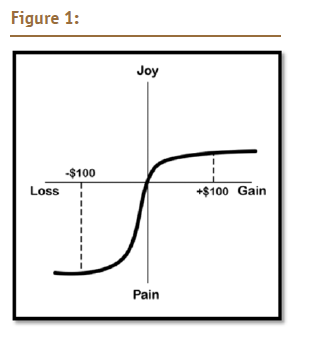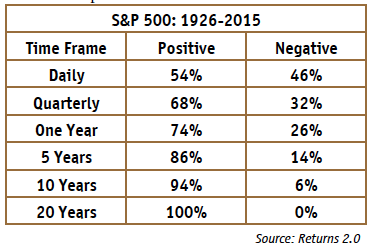Irrational Investing - Why Good People Make Bad Investment Choices
 Most investors I know love new information. The fact that you are reading this right now probably means you do too.
Most investors I know love new information. The fact that you are reading this right now probably means you do too.
Much of the information and advice we receive is based on modern economic theory. In order to generate predictions about investor behaviour, this theory assumes that investors are rational decision makers, assessing probabilities and acting accordingly.
For example, it should be reasonable to assume that Investor A would be willing to risk twice as much for an investment that returns 10% as one that returns 5%. Or, that a loss of 10% would be negated by an equivalent gain.
The reality, however, is quite different.
Consider the following scenario: You are offered a 100% chance of receiving $10000, or a 50% chance of receiving $25000 and a 50% chance of receiving nothing. What would you choose?
The mathematically optimal choice is to take a chance at receiving the $25 000, since 50% of $25000 is $12500 which is still more than the guaranteed $10000. But the vast majority of us would choose the $10000. When we are faced with a high probability of receiving gains, it turns out we are risk-averse.
Now consider another scenario: the choice between a 100% chance of losing $10000, or a 50% chance of losing $25000. What would you choose?
As you may have noticed, the mathematically rational answer is to accept the $10000 loss. But most of us would, in fact, act irrationally by taking the 50% chance of losing more than twice as much. When we are faced with a high probability of loss, turns out we are risk-seeking.
$10000 loss. But most of us would, in fact, act irrationally by taking the 50% chance of losing more than twice as much. When we are faced with a high probability of loss, turns out we are risk-seeking.
What these hypothetical examples illustrate is that human beings have an asymmetrical attitude towards risk. We feel losses more intensely than gains. There is a name for this: loss aversion. Figure 1 on the next page illustrates the idea that the magnitude of pain at losing $100 is much greater than the magnitude of joy at gaining $100.
What this means for investors is that the psychological pain of losing a certain amount of money is not cancelled out by the pleasure of making an equal amount elsewhere. In fact, studies have shown that it would take a gain 2.5x greater to heal the psychological wound of the loss. We are not rational. Let’s look at a few real world examples.
What this means for investors is that the psychological pain of losing a certain amount of money is not cancelled out by the pleasure of making an equal amount elsewhere. In fact, studies have shown that it would take a gain 2.5x greater to heal the psychological wound of the loss. We are not rational. Let’s look at a few real world examples.
Ipos Are Like Lotteries
Study after study has shown that on average IPOs (initial public offerings) are poor investments. Yet many investors, professional and DIY alike, show great interest, hoping to get in on the next Microsoft or Google. These success stories are so well known that our minds have an incredibly difficult time not associating them with other IPOs. This is called availability bias, and it is one reason humans are bad at understanding statistical realities – in this case, that the vast majority or IPOs are poor investments. Like people who play the lottery, we are irrational risk-takers when probabilities are low and potential rewards are high.
The Allure Of Fixed Income
Historically, government bonds have returned 6% less on an annualized basis than equities. In the book, Stocks for the Long Run by Jeremy Siegel (highly recommended by this author), a bulletproof case is made that equities outperform bonds over the long term. Even the conventional wisdom that bonds are less volatile than equities is false over multi-decade periods. Traditional economic theories relying on expected utility have a hard time making sense of the allure of government bonds. Viewed through the lens of our asymmetric attitude toward risk, however, the appeal of bonds makes perfect sense. The inherent volatility of equities, which by definition exposes the investor to losses, may cause great discomfort. Psychologically, the lack of short-term volatility in traditional fixed income products makes them feel less risky, even if over longer time horizons they may be a poor choice.
than equities. In the book, Stocks for the Long Run by Jeremy Siegel (highly recommended by this author), a bulletproof case is made that equities outperform bonds over the long term. Even the conventional wisdom that bonds are less volatile than equities is false over multi-decade periods. Traditional economic theories relying on expected utility have a hard time making sense of the allure of government bonds. Viewed through the lens of our asymmetric attitude toward risk, however, the appeal of bonds makes perfect sense. The inherent volatility of equities, which by definition exposes the investor to losses, may cause great discomfort. Psychologically, the lack of short-term volatility in traditional fixed income products makes them feel less risky, even if over longer time horizons they may be a poor choice.
Buy High, Sell Low
The short-term volatility of equities has another interesting effect on the psyche of investors – it tempts us to buy high and sell low.
Consider the following table showing the chances of positive versus negative returns for the S&P 500 over various time periods.
Most investors look primarily at the short-term fluctuations of equities. When stocks are up, we want in on the action so we buy high. But since losses are felt more acutely than gains, and stocks are down nearly 50% of days, investors who watch the market too closely tend to display risk-averse behaviour. Forgetting their long-term plan, or perhaps failing to make one in the first place, they lock in short-term losses by selling to avoid the chance of further loss, and miss the opportunity to buy when prices are low. Paradoxically, investors who spend less time watching their stocks may do better.
Hold Losers Too Long And Sell Winners Too Soon
We have all had this experience: a stock we once thought was great is seriously underperforming. We know we should sell, but there are so many reasons to hang on, to wait for the “inevitable” recovery. We tell ourselves that the rest of the market is crazy – it’s only a matter of time until the value of the company is realized again. But who is being irrational?
The investor already feels the loss compounded by uncertainty if the stock is not sold. On the other hand, if there is even a small chance of recovery, the investor will likely take it. We are wishful thinkers who abhor loss. It feels better to hold onto our losers.
The flip side of this equation is often seen with our winners. Imagine one of your stocks going up 50% in just a few months. All else being equal, most of us would feel compelled to take our winnings and run rather than risk losing those gains. This illustrates the fact that when presented with a certain gain, but a small risk of loss, we become risk-averse.
Stock Picking
Perhaps the greatest delusion of all is that we just might have the prescience to pick a stock that is about to take off. After all, it happens all the time…or at least it seems to in stories we read and hear. Like lotteries or IPOs, it is the scenario of high rewards but very low probabilities of those rewards that bring out the worst in us. Study after study confirms even professionals’ inability to pick stocks better than dart-throwing monkeys, yet the temptation remains.
The Solution: Humility And A Plan
We all feel the temptation to pick stocks that are going to be winners, the reluctance to let go of our losers, and to play it safe when volatility seems too much to bear. We are wired this way as a result of millennia of evolution. The key to navigating the modern world of investments is to acknowledge the fact that we are not innately good at it.
Once we acknowledge these shortcomings, we can create plans to circumvent them. Adopt more passive rather than active strategies. Ignore the day-to-day market fluctuations and only reevaluate investments every six to 12 months. Pre-plan when you are going to buy and sell rather than reacting to short-term fluctuations.
Spend the time to make a simple, rational and well thought out plan. Then stick to it. As Charlie Munger says:
ìSimplicity has a way of improving performance through enablingus to better understand what we are doing.
Matt Poyner is a DIY investor and participant in the Oshawa Shareclub. matt.poyner@gmail.com

